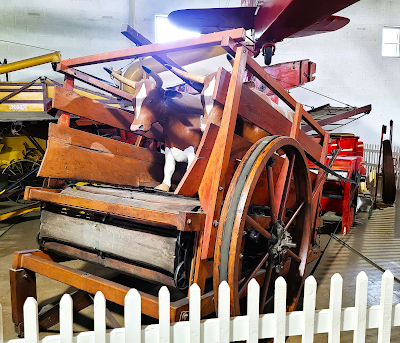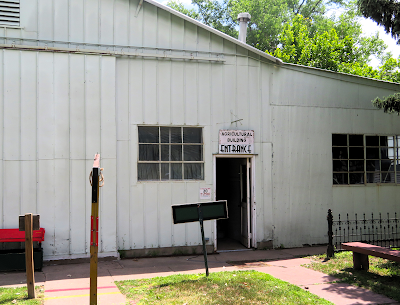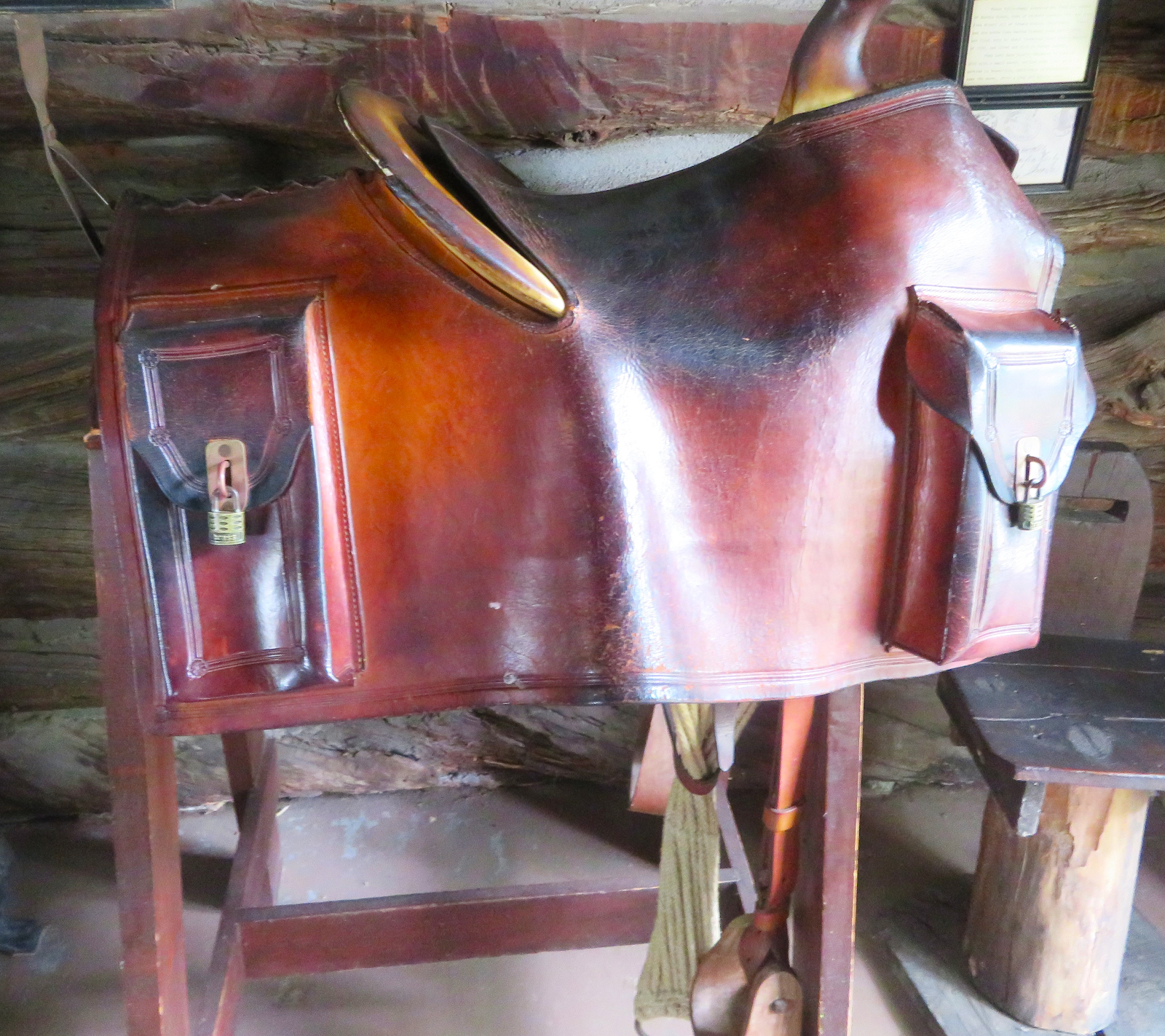…and our visit to the Pioneer Village in Minden Nebraska continues. So many buildings crammed with antiques and collectibles and I was getting generally tuckered out! What didn’t Harold Warp collect for his museum? He was focused on many items but whimsy pops up here and there as well.
By this
point, I’m not 100% sure that I’m correct as regards which items were displayed
in which building. Both Laurie and I
were taking photos. Hopefully I got it
right!
Where
next? This is Pioneer Village Building
#15 which features antique tractors and trucks.
It is home to 100 early farm tractors and other items, including Dave
Buick’s first gasoline engine.
This is a
1919 Ford Model-T Knickerbocker Forma Tractor. This ‘make do with what you have’ tractor was
invented by Walter Guilder from Ohio. An
engineer, Guilder owned an 80 acre farm that his brother worked for the family. Walter had noticed all kinds of truck
modifications of Model-T Fords, so when looking at buying a ‘real’ tractor
($1,200), he decided that if they could be made into trucks, why not a
serviceable tractor.
A
negative article on these types of conversions in “Gas Review Magazine” stated
“You can’t make a real tractor out an automobile any easier than you can make a
draft horse out of a jack rabbit”. In
1916, Guilder signed an agreement with the Knickerbocker Motors Company in
Poughkeepsie New York, to manufacture the necessary part for the conversion kit. The idea was that farmers could ‘easily’
change over their family’s Model-T to a tractor for work on the farm over the
weekend, and then change it back to take the family to church on Sunday.
These
kits sold well enough that Sears, Roebuck and Company as well as Montgomery
Ward and Company, (my former employer), included them in their respective
catalogs. Prices seemed to have ranged
from $178 to about $300 although some other complementary devices were also
offered. They included a better engine
cooling system for the autos used for this purpose. Many conversions using similar kits were used
with various auto brands throughout the 1920s and 1930s.
This
eye-catching tractor is a light-weight OilPull Tractor that was made by the
Advance-Rumely Thresher Company in LaPorte Indiana. The company built these 15 to 25 HP tractors
from 1924 through 1926. They were
described as ‘being adapted to lighter power requirements on the farm’ and as
being ‘compact in construction.
The
Advance-Rumely Company was a pioneering manufacturer of threshing machines,
large tractors and other agricultural equipment. The company was founded in 1853 with
threshers as their primary product.
Later, they moved on to tractors and steam engine manufacturing. In 1931, the Allis-Chalmers Manufacturing
Company purchased Advance-Rumley.
The
collection of a mind boggling list of items continues. This photo shows a line of antique trucks…but
against the opposite wall there is a long line of lawn mowers. What didn't Harold Warp collect?!
Now on to
a couple of those early trucks…
This
awkward looking vehicle is a 1908 Randolph Power Wagon. It and other early trucks were ‘inspired’ by
the introduction of an earlier ‘power wagon’ that was introduced by the
Grabowsky Wagon Co., aka the Grabowsky Motor Co. That company was founded in 1900.
The
advertising for Grabowsky’s Power Wagon claimed that it could ‘do the work of 3
or more horse-drawn wagons’. Other
companies, such as Randolph (shown above), Reo and Mack soon jumped on the
bandwagon. This particular truck was
purchased by a publisher in Chicago to deliver his newspapers. Despite this purchase, horse-drawn wagons
still delivered newspapers well into the 1920s.
When
William (Bill) Durant put together the General Motors Company in 1908, it was
done through the purchase of existing manufacturers. The Randolph Company was one of the companies
folded into GMC. Consequently, the
Randolph Power Wagon was the first GMC truck, with the Randolph name being by the company in 1913.
With that
gigantic bulbous hood, this 1913 7.5 ton Mack truck is an ungainly looking
‘beast’. Back in the 1910s and 1920s
Mack trucks were considered to be the most rugged on the road. The company stuck with a chain drive instead
of a shaft drive which other truck makers had adopted. Mack trucks also utilized solid rubber wheels
vs. the pneumatic wheels used by other manufacturers. Trucks like this one were primarily used to
deliver coal to homes and businesses in the cities.
Mack
Trucks, Inc. not only build trucks but also buses and trolley buses. The company was founded in 1900 in Brooklyn
New York as the Mack Brothers Company…and eventually all 4 Mack brothers were
involved in the business. The company
built its first truck in 1905. Originally, their vehicles were called
“Manhattan” trucks, etc. but in 1910 they switched to “Mack”. Today, Mack Trucks is a subsidiary of AB
Volvo...
This
rather primitive looking truck was built by the Republic Motor Truck Company in
1920. It was acquired by Harold Warp for
Pioneer Village in 1954. It had a cargo
capacity of 4 tons…had a 4 speed transmission, ‘4-wheel’ brakes and a
handbrake. Its 6 cylinder motor produced
36 HP. An ad for Republic Trucks stated
that “Standard equipment includes a speedometer, ammeter, air cleaner, gasoline
strainer, electric head and tail lamps, a front bumper, radiator guard, front
fenders and a horn”. What a great deal!
The
Republic Motor Truck Company was based in Alma Michigan and they built
commercial trucks from 1913 until 1929.
By 1918, it was the maker of 1 out of every 9 trucks on the road in the
USA. During WWI, Republic was one of the
major suppliers of “Liberty trucks” used by American troops during the
war. Over 3,000 dealers served the
company in the USA and there were additional Republic dealers in at least 56
foreign countries and colonies.
At the
end of WWI, Republic had an annual production capacity of 30,000 trucks a
year. The bad news was that a postwar
depression plus the return of thousands of Liberty trucks to the United States,
combined to bring about a major decline in demand for new trucks. The company closed in 1929.
Laurie
took this photo of an old-time threshing machine that is on display in Building #14, the Antique Farm Machinery Building. In this case an ox is providing the power for the machine. Most
animal driven threshers were powered by horses.
Before such machines were developed, it was all about hand threshing, a
very labor intense function. About 25%
of total farm labor prior to animal driven and motor driven threshing, was
taken up by this activity. The first
threshing machine was invented ca. 1786 by a Scottish engineer named Andrew
Meikle.
Building #14 is 265 feet long and it shows the equipment that was part of the evolution, of cultivating, seeding, harvesting and threshing crops. This has to be a must stop for anyone who is involved in or was involved in farming.
Building #20 has a rather inauspicious entrance. Once again, never judge a book by its cover. This is the Agricultural and Steam Tractor Building. This 2-story structure contains more than 500 agricultural tools and implements…all of which contributed to America’s enormous farm economy. The second photo is intended to give viewers an idea of the size and scope of this collection.
Important
Note: Given
the exhaustive collection of just about anything from America’s past, one item
in the second photo deserves special note!
That would be the church pew or railway style waiting room bench in
front of the faux horse. Pioneer Village
must have sewed up the market for benches like this. They are everywhere almost every building and,
for some of us, they are truly important if we have any hope of touring all or most
of the village.
This is a
1917 Aultman-Taylor steam tractor. It is
the largest of the 3 sizes the company offered, producing between 30 and 60 HP
depending on the application. In 1955, it
took 2.5 days for this tractor to cover the 50 miles between the farm where it
came from and Pioneer Village.
The
Aultman-Taylor Machinery Company of Mansfield Ohio began with the C. Aultman
Co. that was founded in 1859. The
company built steam engines and threshing machines and it wasn’t until ca. 1910
that the company began building steam tractors.
The company was taken over by the Advance-Rumely Thresher Company of
LaPorte Indiana in 1924
This is another Advance-Rumely Tractor. In this case its a 1918 Advance-Rumely Oil Pull Tractor. It
is equipped with a 2 cylinder engine that developed between 20 and 40 HP. I noted a ‘slick’ marketing advertisement
posted by this tractor. It was taken
from a 1907 copy of “The Threshermen’s Review”.
The snazzy byline reads “Why are Rumely goods selling so well? Because it pays to have them.” Wow, how advertising has changed over the
years! The Rumely Oil Pull was a line of
farm tractors developed by the company starting in 1909, which was sold from
1910 to 1930.
The Advance-Rumely Company of LaPorte Indiana was was best known for
its threshing machines and big tractors. Of interest to me was the Oil Turn line of
tractors. To start one, the
farmer/operator had to step out of the cab onto that large iron rear wheel,
then climb onto the flywheel and use his bodyweight to get it turning. Then he’d have to quickly get back in the cab
to adjust the choke to keep the engine turning. Talk about dangerous and sometimes frustrating work!
Hundreds
of these old steam powered tractors have been saved, rebuilt and shown at fairs
and tractor shows. Watching a 10 to 20
ton tractor belching smoke and clanking along is still possible. Check out the National Threshing Association’s
annual show in Fulton County Ohio. The
next show/exhibit will be in June of 2024.
Website: National Threshers Association, Annual Steam Traction Engine
Show.
Thankfully, this building was small and touring it was easy! This is the former Pony Express Black Hills relay station. Originally called the “Pumpkinseed Relay Station”, it was moved to Pioneer Village from Bridgeport Nebraska. Harold Warp only paid $100 for it. The Pony Express route covered 1,966 miles and the riders could complete the trip in just 10 days! The Pony Express only operated from April of 1860 until October of 1861, when it was supplanted by the completion of the coast-to-coast telegraph system. Nebraska had 565 miles of the Pony Express’s route along with 38 relay stations.
This is a
replica of a Pony Express saddle and Mochila.
It was crafted in 1961 based on the schematic for the original
saddles. The saddle itself was built to
minimize weight so it wasn’t the most comfortable for the riders. The riders themselves couldn’t weigh more
than 125 pounds! The Mochila fit over
the saddle and it could quickly be transferred from horse to horse as
needed.
To
emphasize just how expansive Pioneer Village is, there are 26 buildings plus a
bandstand. The Household Appliance
Building shown above is one of those that we skipped because we were
overwhelmed and tired. Plus we had a significant
drive ahead of us back to the family home in Omaha.
The Home
Appliance Building (#24) features the evolution of washing machines, stoves,
refrigerators, bathtubs, and much more.
The Valentine Diner was closed during our visit and the Steam Powered
Merry-Go-Round was under repair. But we
also skipped: the Country School (#7); the China House with china, pottery, cut
glass, etc. (#9); the Blacksmith Shop (#21); the Pony Express Barn (#22), and;
the Horse Barn (#12).
We did
visit one more building and then we discovered that there was yet another
portion of the main building that we hadn’t seen. Those last stops, plus a couple of
interesting ‘collectibles’ that I’d missed in previous posts, will be included
in the final edition of our family adventure.
Just
click on any of the preceding photos to enlarge them…
Thanks
for stopping by for a visit!
Take
Care, Big Daddy Dave















Some really cool tractor / trucks...is this museum again entry free?
ReplyDeleteWhat lots of farm machines, tractors etc. I'd have skipped some of what you were interested in and gone to some other exhibits. It is truly a museum that has saved a lot of old things that no longer are around.
ReplyDeleteEs una bella aldea. La maquinaria esta muy bien conservada. Te mando un beso.
ReplyDelete